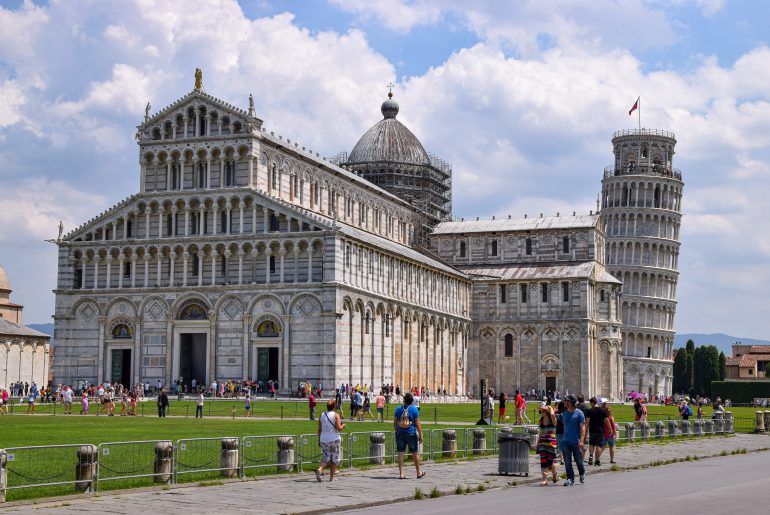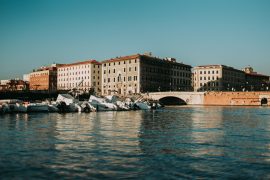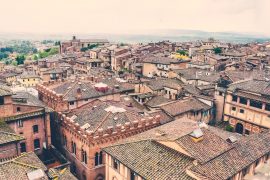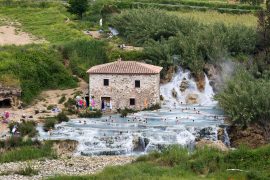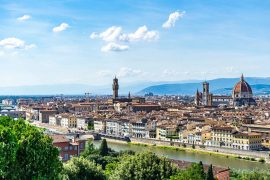Pisa is a city located in Tuscany, located on the Arno River. Associated primarily with the most popular monument which is the Leaning Tower. It is one of the most famous buildings in the world, visited by tourists in large numbers every year. Pisa was founded by the Etruscans or Ligurians. Between the 10th and 12th centuries it became a powerful republic. It was then that the city gained municipal rights, and the construction of a cathedral and a baptistery began. Today Pisa is one of the most visited cities in Italy. There you can visit numerous museums, reach the San Rossore National Park and go to the coast, which is about 20 km from the center. The beautiful seaside resorts are sure to appeal to those who enjoy beachcombing and active recreation. Pisa is an ideal place to explore on foot, or by bicycle, which is a very popular means of transportation due to the limited car traffic in some parts of the city. Numerous aquaparks make many families choose this region for a vacation with children. For those who enjoy walking among nature, the Botanical Garden of Pisa is particularly recommended.
What to see. Attractions in Pisa
Leaning tower
It is the most popular building that attracts hundreds of tourists from all over the world. It has become a symbol of Pisa. It is located on Campo dei Miracoli (the so-called Miracle Square) along with two other monuments - the Cathedral and the Baptistery. It was designed by Guglielmo and Bonanno Pisano. Construction of the Leaning Tower began in 1173. Initially, the tower began to deviate from the vertical. It was built in 3 stages, and the whole process took 199 years. Currently, the tower is 54.98 meters high and is deflected from the vertical by less than 5 meters. It currently serves as a cathedral bell tower. In 2011, the restoration of this monument was completed. It was handled by a team of geotechnics professor from the Polytechnic University of Turin Michele Jamiolkowski. After 20 years, the tower was stripped of dirt from the masonry, and the foundations were reinforced and methods were used to prevent further tilting. The tower is made of white marble and has eight stories. In 1987 it was declared a UNESCO World Heritage Site along with the entire complex of monuments in Piazza del Duomo.
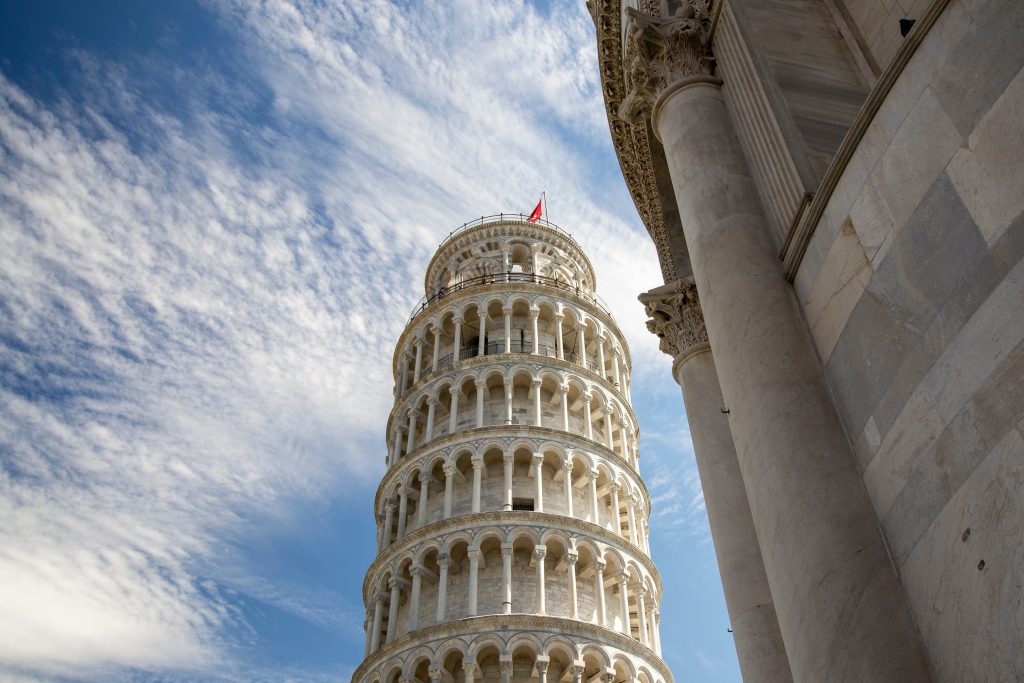
Piazza del Duomo
This is the most popular square in Pisa. It houses 4 monuments of medieval architecture considered the most important in the city. They are: Cathedral of Santa Maria Assunta, Baptistery of San Giovanni, Leaning Tower and Camposanto Monumentale. Admission prices for each site are described at www.opapisa.it/en/tickets/prices/. It also provides information on how to connect or purchase individual tickets to the various structures located in the Piazza del Duomo.
Cathedral of Santa Maria Assunta
The Cathedral of Santa Maria Assunta is one of the most beautiful buildings in Pisa representing a masterpiece of Romanesque architecture. It was built in 1064. Over the years the building has been conserved, the naves and the dome have been added. The interior of the cathedral is rich in numerous masterpieces, for example: the tomb of Emperor Henry VII or the Gothic sculpture of the pulpit by Giovanni Pisano. At the center of the temple is the so-called "lamp of Galileo". It is a chandelier made of brass with bronze sculptures. Due to the reputation of the place, the Duke of Milan Gian Galeazzo Visconti summed it up as "the eye in the head of the Pisans."
Baptistery of San Giovanni
The Baptistery of St. John the Baptist was built in 1152 to administer baptism and as a complement to the Cathedral. It is the largest baptistery in Italy. It was designed on the model of the Dome of the Rock in Jerusalem. There are 8 columns in the center, with a gallery of women above them. In the center, the attention is drawn to the octagonal baptismal font, which was made by Guido Bigarelli.
Camposanto Monumentale
It is a campo santo type cemetery. It was created as the last of the Piazza del Duomo complex. It was founded in 1277 to sort out the graves scattered around the Cathedral. At the beginning of the 19th century it gained the status of a public museum. The cemetery is rectangular in shape and surrounded by Gothic cloisters. In the 14th century, the interior walls were decorated with frescoes by Francesco Traini and Bonamica Buffalmacca, but as a result of the damage done during World War II, most of the works were severely damaged. Eventually, the cemetery was rebuilt, and the preserved frescoes were transferred to the Museo delle Sinopie in Pisa.
Palazzo Blu
It is a center for temporary exhibitions and cultural events, located in the historic center of Pisa. Palazzo Blu also has a permanent exhibition. The building is named after the color of the facade - blue. The Palace houses a museum containing more than 300 works of art. There are also paintings from the 14th to the 20th century.
What else to see? Other attractions
Every year on June 16 is the Luminara di San Ranieri, or festival of the patron saint of Pisa. This day has been lavishly celebrated by the city's residents since the 1700s, and has been called Luminara since the 1800s. Beautiful lights placed on buildings along the Arno River illuminate and sparkle in the reflection of the water. In the Piazza dei Miracoli, you can enjoy natural lighting from oil lamps along the arches of the Leaning Tower. At midnight, there is a fireworks display adding an extra special touch to the celebration. You can stroll along the river, admiring the unique views and the illuminated city, and enjoy Italian specialties sold at roadside stands. When planning a trip to Pisa, it is certainly worth taking part in such an event, which takes place only once a year. An interesting place that is also worth seeing is Keith Haring's mural entitled "Tuttomondo." It is located on the wall of the Church of Sant'Antonio Abate in Pisa. The figures depicted in the mural symbolize various aspects of world peace. The Tuscany region is also famous for its hot springs. This is one of the most popular attractions. Most of them are free, which makes them the most attractive way to spend time. The nearest thermal baths are Bagni di Petriolo, about 150 kilometers from Pisa. A relaxing swim in hot water in the vicinity of nature, is there a better way to relax?
Beaches near Pisa
One of the most popular places to relax near Pisa is Versilia (the route to this place is about 25 kilometers). The most famous resort in this place is Forte dei Marmi. The beaches there are wide and sandy. There are a number of facilities for tourists: umbrellas, sunbeds, showers, and there are bars and discos and luxury boutiques nearby. Safety on the beach is guarded by a lifeguard. Another place worth visiting is Livorno Located 25 kilometers from Pisa. It features rocky beaches. The descents can seem steep. There are also natural rock pools where you can dive and admire underwater vegetation and fish. Another must-see on a trip to the Tuscan coast is Marina di Pietrasanta located about 30 kilometers from Pisa. This place is ideal for those who appreciate peace and quiet and want to relax in the vicinity of forests and mountains, while taking a dip in the sea.
Getting to Pisa
To get to Pisa you can choose to fly by plane or travel by car. Ryanair airline offers flights from cities such as Gdansk, Krakow, Warsaw and Wroclaw. One-way tickets for one person can be found from as low as PLN 69. The airport is 2 kilometers from the center of Pisa. This distance can be covered on foot or by bus. Another option is also car rental, or taking a cab. Planning to travel to Pisa by your own car, you should know that the route is about 1350 kilometers. Using such a means of transport, you should remember about tolls for vignettes, parking and highways. A major advantage of such a car trip is the opportunity to visit cities along the route leading to Pisa. Brno, Vienna are certainly worth a visit, Bologna and Florence.
Public transportation in Pisa
While in Pisa, you can take a bus, a streetcar, or a cab. You can also explore the city on foot, which is very convenient, especially because of traffic jams. Getting around in your own car can be a problem, as Pisa is crowded and parking spaces are scarce. Cars parked on the streets are often scratched, so you should be really careful when using your own or rented vehicle. You can also take the bus or, streetcar. Tickets can be purchased at kiosks or vending machines and punched before entering the vehicle. If you want to go to the coast, you can also use trains, which are used to move between cities.
Cuisine. What to eat while in Pisa?
Italian cuisine is known all over the world. It is famous for its simplicity and the best ingredients. When going to Pisa, you should especially try regional cheeses and cured meats. Many restaurants serve specially composed antipasti, or snacks. It is worth mentioning that Tuscany is famous for its unsalted bread, which is the basis of many sandwiches served from roadside establishments. Products that come from the region include: cheese Pecorino, San Miniato truffles and tomatoes Pisanello. While in Pisa, you should taste a soup called ribollita. It consists of beans and cabbage called cavolo nero, of the variety found only in this region. A popular dish is also fritto misto, or fried fish and seafood. One of the most popular desserts is torta coi bischeri Which is a tart with almonds, nuts, chocolate and candied fruit.
Weather in Pisa
The warmest months of the year in Pisa are June, July, August and September. The average daytime temperature in these months is above 20°C. This is also when the number of hours of sunshine is the highest of the year, at about 10. The coldest months of the year are December, January and February. During this time the average daytime temperature is below 10°C, and the number of hours of sunshine is 5. The most frequent rainfall can be expected in October and November.
Accommodations. Where to sleep in Pisa?
Accommodation in Pisa depends largely on location and guest amenities. One of the most recommended places is the Grand Hotel Duomo located right next to the Leaning Tower and 20 minutes from the Pisa Centrale train station. The hotel has a restaurant with Italian delicacies and a rooftop terrace overlooking the city skyline. The price for an overnight stay for two with breakfast is 377 zloty. Another place worth noting is La Pace. This is a hotel located about 80 meters from the train station. It offers an American-style bar and a TV lounge. The hotel serves a buffet breakfast. The price for an overnight stay for 2 people is 314 zlotys. The Harmony House Prestige is also highly recommended by guests. It will be an ideal place for those who appreciate peace and quiet. It is located in a quiet area and has a 100 m² garden. It is a 10-minute walk from the train station. The price for an overnight stay for two people with breakfast is PLN 348.

